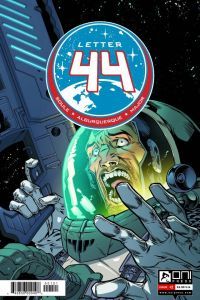Just like in the first issue, the plot and setting in "Letter 44" #2 by Charles Soule and Alberto Jimenez Alburquerque is split between Washington DC and outer space, as President Blades settles in his first few days in office and the crew of the Clarke spacecraft gets closer to the alien-designed Chandelier machine in the asteroid belt.
The idea behind "Letter 44" -- a behind-the-scenes view at the White House preparing for an alien invasion -- is a good one, but Soule's script suffers from uneven exposition and clunky pacing.
Soule opens with Dr. Portek dishing out a three-page-long persuasive speech, starting with a series of seemingly rhetorical questions to lead the president around to Portek's way of thinking. This is a lot of talking-heads action as a lead-in, and while Soule's dialogue for Portek has an engaging, natural flow to it, it's a lot of information to dump onto the reader. The pace of disclosure feels rushed and compressed, and a lot of the cinematic suspense is diminished because the events Portek refers to are in the past.
In the following scene, Soule switches to showing instead of telling, but the back-and-forth dialogue between President Blades and his advisors lacks the animation and the rhythm that characterized Portek's manipulative monologue. The following scenes switch rapidly between outer space and then to Project Monolith's HQ in Arlington, VA, and then back again to the Clarke. There's a lot of activity in these pages, but it feels like noise due to a lack of suspense and character development. The dialogue in these scenes is often flat or lazy-feeling. Platitudes like "The answer's there. We'll find it" flatten the interactions. Similarly, the ending cliffhanger lacks punch because the concept of a one-way trip has been overused in science fiction, and Soule's only twist to it is a space pregnancy, which is admittedly a cool idea.
President Blades remains a sympathetic protagonist, especially in his reaction to military R&D being held in reserve, but so far, none of the other characters have much depth. While this isn't such a problem for all military men around the President, since they all seem to have ulterior, potentially villainous motives, the lack of strong character development among the Clarke crew is a problem. While Soule attempts to add some quiet moments like Gabriel's contemplation in the garden, it's too soon for the reader to care about intra-crew camaraderie or tension.
Alburquerque's art exacerbates the characterization and pacing problems. His panel layout for the scene in the Clarke's clinic is confusing, not making it immediately clear to the reader that the action is switching back and forth between two doctors and two patients. Every male character has unrealistically proportioned, overly pronounced chins and cheek bones. Facial expressions are either cartoonishly exaggerated or rubbery and dull, and therefore not up the task of conveying the appropriate emotions in the earth-shaking revelations of the plot.
The scenes set in outer space are particularly confusing. The colored speech balloon outlines hinder the flow of reading. The colors do not seem to correspond to the same characters consistently, and in any case, there ought to be a less distracting way to differentiate one suited-up character's speech from another's.
Like the first issue, "Letter 44" #2 is marred by clumsy narration and heavy-handed world-building. Further issues might be able to iron this out, but for now, the storytelling poorly executes a promising concept.

